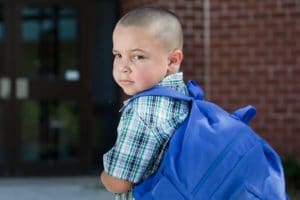For most teachers, myself included, the start of school in August 2020 was unlike anything we had ever experienced. In the fall, instead of returning to our old way of doing things, many of us continued to teach the online classes we had swiftly developed in the spring when the global COVID-19 pandemic shut down our daily lives and forced instruction onto Zoom.
Some teachers used a hybrid mode of instruction, teaching students online and in the classroom simultaneously. For students and teachers fortunate enough to be on campus, social distancing, masks, and hand sanitizers became our new normal.
Now that vaccines are available to most adults, we’re experiencing cautious optimism that our return to school this fall will feel more like the “old normal.” But what will August really look like for teachers?
I reached out to Natalie Hierholzer, San Antonio’s North East Independent School District (ISD) Director of Guidance Services, to learn more about how COVID-19 will continue to impact our instruction in the 2021-22 school year. With seven years of experience as an elementary school teacher and 23 years as a high school counselor, Hierholzer was well-prepared to support the district’s teachers and counselors in their abrupt transition to online learning in spring 2020, and she is now preparing for teachers and students to return to campus this August.
For Hierholzer, the pandemic has provided three lessons for on-campus teaching:
- A continued enhanced use of technology in the classroom;
- A focus on students who are at-risk, and
- Social emotional learning trainings to reinforce academic success.
Technology Is Not Going Away — And That’s a Good Thing
While few of us anticipated the sudden shift to technology in teaching, in many ways, the COVID-19 crisis response has provided positive opportunities for enhanced use of technology in the classroom and beyond. As was the case in many districts, the teachers and staff at North East ISD were quick to adopt remote instruction in spring 2020.
“Our counselors and teachers really stepped up,” Hierholzer, who oversees program implementation for 170 school counselors at 67 campuses, told me when we spoke by telephone. “Everyone learned Zoom really fast and figured out how to do things remotely. Our counselors created interactive videos and provided individual virtual counseling, though there were fewer opportunities for group counseling because of privacy concerns.”
This new technological expertise will continue to enhance students’ lives even as teachers return to an on-campus mode of instruction this fall.
“We have learned a lot about how to reach our students,” Hierholzer noted, observing that even first-graders were able to participate in Zoom chats and attach documents to online assignments. “Some of the things we learned during the pandemic will continue to be used going forward. Our teachers are all computer savvy and took online teacher training. I think technology will be integrated into the classroom at all grade levels this fall.”
Hierholzer also emphasized that online collaboration with colleagues in professional learning communities will continue, as will virtual tutoring hours for students. Virtual school will also likely continue in some fashion, providing a valuable new learning experience for students who may not function well in a traditional classroom environment.
Introverts and At-Risk Students May Struggle to Adapt
It’s worth noting that for some students, especially those who identify as introverts, the abrupt switch to online schooling in 2020 was actually a positive development.
“Some of our students were actually in their comfort zone for the first time with virtual school,” Hierholzer said.
For other students, the pandemic created overwhelming life challenges. How can teachers help these at-risk students to socialize in a classroom environment? The first week of school will be critical to identifying students’ needs and setting them up with resources for success.
“Where have these kids been? How are they? Some have been fine, but some have experienced death or financial hardships because of the pandemic,” Hierholzer explained. “Every teacher needs to know where their kids are so they can develop personal relationships. Administrators need to know this about their teachers too.”
During COVID-19, North East ISD implemented a robust tracking system for at-risk students, where information could be shared with counselors and teachers. “What we learned in the pandemic will be helpful going forward. We can keep track of at-risk students to get them the support they need,” Hierholzer said.
However, Hierholzer also stressed that many students have done remarkably well with the abrupt changes brought on by the pandemic. “Kids are pretty resilient, sometimes more than we give them credit for,” she said.
Social Emotional Learning Is Critical to Academic Success for All Students
Even before the pandemic, North East ISD counselors and teachers were focused on social emotional learning as a tool for student success, and that knowledge will be even more important this August as students return to campus. In a social emotional learning context, modeling warmth and compassion is key. North East ISD relies on a social emotional learning framework with the following guiding principles:
- Self-awareness
- Social awareness
- Responsible decision making
- Relationship skills
- Self-management
“What that first day looks like in August will depend a lot on the work we are doing now,” Hierholzer observed.
Hierholzer’s plans for North East ISD make sense for most public schools. She offered seven key areas that the district is focusing on to make sure that teachers and administrators are prepared to serve their diverse student populations this August.
- Multiple open house low-stress opportunities for students to return to campus over the summer.
- Expanded summer school for elementary school students to address learning gaps.
- Relaxation rooms and spaces for students to self-regulate and manage stress.
- Social emotional learning focus for teacher training.
- Integrated social emotional learning curriculum in every classroom.
- Partnerships between teachers and counselors.
- Enhanced tracking systems for at-risk students
Hierholzer also focused on the positives. “Our teachers are so excited to come back!” she told me, echoing the attitude I have heard from so many of my own colleagues.
While she conceded that some students and parents might continue to have safety concerns, Hierholzer believes that her district is already doing the right things to address those concerns proactively. While this fall may not be our “old normal,” we may actually experience something better — a learning environment informed by compassion.
For More Information: North East ISD provides more information about Social Emotional Learning here: https://www.neisd.net/sel.










